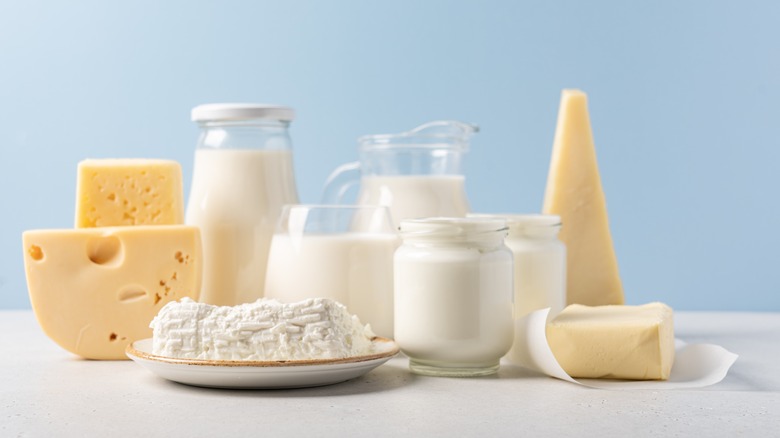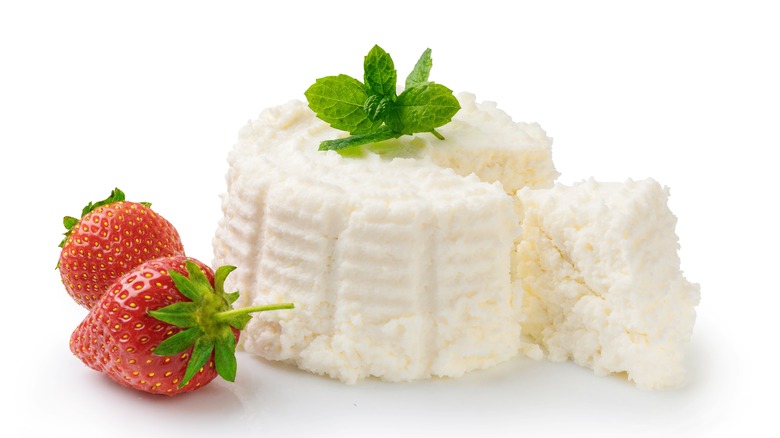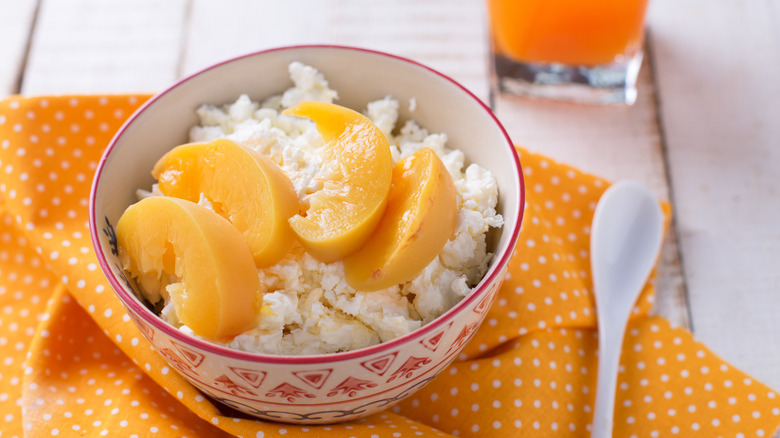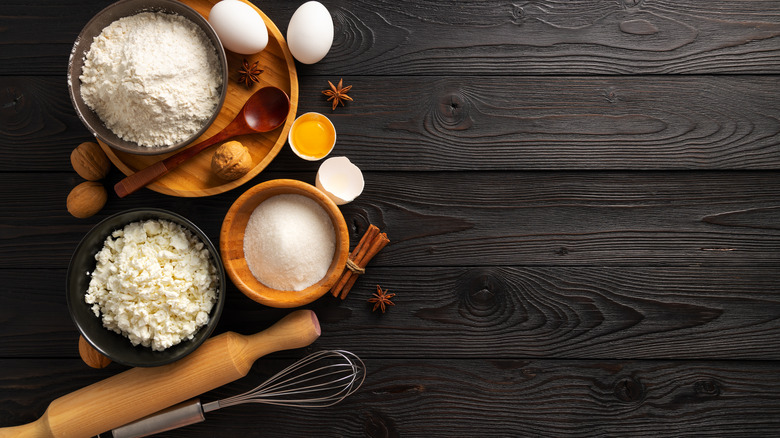The Difference Between Cottage Cheese And Ricotta
Whether you're a professional chef or a novice at home, cooking with cheese — rather than just snacking on it as is — opens up a world of possibilities. Cheese adds richness, flavor, and creaminess to any dish. But how do you choose the right one? Cheese is just cheese, right? That will make true cheese enthusiasts roll their eyes in frustration. Proudly Cheese Wisconsin writes that there are over 1,800 different types of cheeses in the world, and each one has its own taste, texture, and use. Still, some cheese varieties are more similar than others, and you might have to take a closer look to suss out what makes each unique.
Take cottage cheese and ricotta, for example. Both are common kitchen ingredients, and you'll them in dips, side dishes, appetizers, and main dishes. They can even be a bit confusing as you're shopping for them in the grocery store; their containers look alike, the color is nearly identical, and the texture although not exactly the same, is quite similar. So what actually sets them apart?
What is ricotta cheese?
They may look alike but cottage cheese and ricotta have their differences. The biggest difference is that technically, ricotta isn't a cheese at all, even though we call it one. Stubborn Seed tells us that ricotta cheese is actually made from whey or the liquid and milk solids left over in the cheesemaking process. When making cheese, cow's milk is heated until it curdles. The curds are then stretched, separating them from the whey, and that leftover whey is then used to make the ricotta.
From there making ricotta is simple. The whey is cooked, usually with some whole milk and citrus or vinegar to help it curdle and that's about it. Creamy, delicate, ricotta is born. This process is actually the second time the whey is cooked (first to make the initial cheese and then to make the ricotta), hence the name, ricotta, which means "recooked."
Because ricotta is made from whey, it's naturally low in fat; however, you'd never know since it has a creamy texture and a lovely, nutty flavor. When eating or using ricotta, you'll notice that although it is creamy and smooth, there are small granules in it from the curdling process. Compared to cottage cheese though, it has a much smoother texture.
We can thank the Italians for ricotta. They felt nothing should be wasted in the kitchen and came up with the idea to use the leftover whey. It's why you've likely tasted ricotta in a plethora of pasta dishes, especially lasagna. In Italy, however, where cheese reigns supreme, ricotta is found in many other recipes. There you'll experience this delicate cheese in baked goods (hello, ricotta cheesecake), salads, hors-d'oeuvres, and many, many pasta dishes.
What is cottage cheese?
As for cottage cheese, your mom may have served it with fruit on top and hopefully, you thanked her for it. Cottage cheese is good stuff and mom knew what she was doing. Unlike ricotta, cottage cheese is made with milk solids, according to Undeniably Dairy. During the process, acid is added to milk, and the resulting milk solids or curds are separated from the whey, then salted, and voila you have the cottage cheese you can enjoy as a snack or in various dishes.
The California Dairy Pressroom writes that this popular cheese was brought to America by European immigrants who for centuries had been making cottage cheese with milk that had soured. It's thought to be the first cheese made in America. Who knew your little container of cheese had such a proud history? On top of that, it's a great addition to your diet. Cottage cheese is an ingredient in many dishes, like dips, it's often eaten by itself or served topped with fruits or vegetables.
If you've experienced both cottage cheese and ricotta, then you know the difference in texture. It's obvious that cottage cheese comes from a curdling process. Cottage cheese is chunky and looks curdled. The sizes of curds vary depending on the style you choose, though small- and large-curd cottage cheese taste the same and have the same creamy, soft texture. Because of this creaminess, cottage cheese melts easily in recipes. As for flavor, cottage cheese has a saltier flavor than ricotta since salt is added during the making of cottage cheese.
If you love cottage cheese, keep enjoying it. It's full of protein (28 grams per serving) and low in calories so go ahead and eat your cottage cheese in any way shape or form that you like. Your mom would be proud.
Swapping one for the other
Certainly, you've been there; you're making a recipe and missing an ingredient, so you start looking around wondering if it can be replaced with something else. Thankfully, when it comes to ricotta and cottage cheese, they are often interchangeable. Lasagna may have made ricotta famous, but Shelf Cooking explains that cottage cheese is an acceptable go-to when you have a hankering for those layers of Italian pasta but no ricotta on hand. It's a decent swap in most pasta dishes too. Ricotta is also often called for in dips, and cottage cheese usually works well in its place, or vice versa.
Just keep in mind that cottage cheese is usually a little saltier and lumpier than ricotta, so you might have to adjust your recipes accordingly (via Masterclass). The one difference you'll want to pay the most attention to is the difference in liquid content. Cottage cheese can be a little runny, so you may want to strain it a bit before using it as a substitute for the creamier, thicker ricotta. Still, these are minor considerations; if you need ricotta but only have cottage cheese on hand, you'll probably be just fine.
So even though this cheese and not-quite-cheese are made through unique processes and have their own distinct tastes and textures, at the end of the day, they're both delicious and you can probably get away with a secret swap in many of your dishes. Shh! We won't tell anyone.



